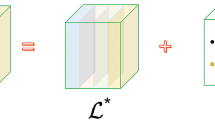Abstract
Alternative least squares (ALS) algorithm is considered as a “work-horse” algorithm for general tensor factorizations. A common form of this algorithm for nonnegative tensor factorizations (NTF) is always combined with a nonlinear projection (rectifier) to enforce nonnegative entries during the estimation. Such simple modification often provides acceptable results for general data. However, this does not establish an appropriate ALS algorithm for NTF. This kind of ALS algorithm often converges slowly, or cannot converge to the desired solution, especially for collinear data. To this end, in this paper, we reinvestigate the nonnegative quadratic programming, propose a recursive method for solving this problem. Then, we formulate a novel ALS algorithm for NTF. The validity and high performance of the proposed algorithm has been confirmed for difficult benchmarks, and also in an application of object classification, and analysis of EEG signals.






Similar content being viewed by others
Explore related subjects
Discover the latest articles and news from researchers in related subjects, suggested using machine learning.References
Abadir KM, Magnus JR (2005) Matrix algebra (econometric exercises). Cambridge University Press, URL http://www.amazon.com/exec/obidos/redirect?tag=citeulike07-20&path=ASIN/0521822890
Albright R, Cox J, Duling D, Langville AN, Meyer CD (2006) Algorithms, initializations, and convergence for the nonnegative matrix factorization. Tech. rep., NCSU Technical Report Math 81706, URL http://www.wfu.edu/~plemmons/papers.htm
Cichocki A, Phan AH (2009) Fast local algorithms for large scale nonnegative matrix and tensor factorizations. IEICE 92-A(3):708–721 (invited paper)
Cichocki A, Zdunek R (2006) Multilayer nonnegative matrix factorization. Electron Lett 42(16):947–948
Cichocki A, Zdunek R, Choi S, Plemmons R, Amari S (2007) Nonnegative tensor factorization using Alpha and Beta divergencies. In: Proceedings of IEEE international conference on acoustics, speech, and signal processing (ICASSP07), vol III, Honolulu, pp 1393–1396
Cichocki A, Washizawa Y, Rutkowski T, Bakardjian H, Phan AH, Choi S, Lee H, Zhao Q, Zhang L, Li Y (2008) Noninvasive BCIs: multiway signal-processing array decompositions. Computer 41(10):34–42. doi:10.1109/MC.2008.431. http://www.ieeecomputersociety.org/
Cichocki A, Zdunek R, Phan AH, Amari S (2009) Nonnegative matrix and tensor factorizations: applications to exploratory multi-way data analysis and blind source separation. Wiley, Chichester
Gillis N, Glineur F (2008) Nonnegative factorization and the maximum edge biclique problem. CORE Discussion Papers 2008064, Universit catholique de Louvain, Center for Operations Research and Econometrics (CORE), URL http://econpapers.repec.org/RePEc:cor:louvco:2008064
Hancewicz T, Wang JH (2005) Discriminant image resolution: a novel multivariate image analysis method utilizing a spatial classification constraint in addition to bilinear nonnegativity. Chemometr Intell Lab Syst 77:18–31
Harshman R (1970) Foundations of the PARAFAC procedure: models and conditions for an explanatory multimodal factor analysis. UCLA Working Papers Phonetics 16:1–84
Higham DJ, Higham NJ (2005) MATLAB guide, 2nd edn. SIAM
Higham NJ (2002) Accuracy and stability of numerical algorithms, 2nd edn. SIAM, Philadelphia, xxx+680 pp. ISBN: 0-89871-521-0
Horn RA, Johnson CR (1990) Matrix analysis. Cambridge University Press, Cambridge
Kim YD, Choi S (2007) Nonnegative Tucker decomposition. In: Proceedings of conference on computer vision and pattern recognition (CVPR-2007), Minneapolis, Minnesota
Kivinen J, Warmuth M (1997) Exponentiated gradient versus gradient descent for linear predictors. Inform Comput 132
Kolda T, Bader B (2009) Tensor decompositions and applications. SIAM Rev 51(3):455–500
Langville AN, Meyer CD, Albright R (2006) Initializations for the nonnegative matrix factorization. In: Proceedings of the twelfth ACM SIGKDD international conference on knowledge discovery and data mining, Philadelphia
Lee D, Seung H (1999) Learning of the parts of objects by non-negative matrix factorization. Nature 401:788–791
Lee H, Kim YD, Cichocki A, Choi S (2007) Nonnegative tensor factorization for continuous EEG classification. Int J Neural Syst 17(4):1–13
Lee H, Yoo J, Choi S (2010) Semi-supervised nonnegative matrix factorization. IEEE Signal Process Lett 18
Lin CJ (2007) Projected gradient methods for non-negative matrix factorization. Neural Comput 19(10):2756–2779
Mørup M, Hansen L, Arnfred S (2006) ERPWAVELAB a toolbox for multi-channel analysis of time-frequency transformed event related potentials. J Neurosci Methods 161(2):361–368
Mørup M, Hansen L, Parnas J, Arnfred S (2006) Decomposing the time-frequency representation of EEG using non-negative matrix and multi-way factorization. Tech. rep., URL http://www2.imm.dtu.dk/pubdb/p.php?4144
Nion D, De Lathauwer L (2008) An enhanced line search scheme for complex-valued tensor decompositions. Application in DS-CDMA. Signal Process 88(3):749–755
NVIDIA (2008) NVIDIA CUDA Programming Guide 2.0. NVIDIA, Santa Clara
Paatero P (1997) Least-squares formulation of robust nonnegative factor analysis. Chemometr Intell Lab Syst 37:23–35
Paatero P (1997) A weighted non-negative least squares algorithm for three-way PARAFAC factor analysis. Chemometr Intell Lab Syst 38(2):223–242
Phan AH, Cichocki A (2008) Multi-way nonnegative tensor factorization using fast hierarchical alternating least squares algorithm (HALS). In: Proceedings of The 2008 international symposium on nonlinear theory and its applications, Budapest
Phan AH, Cichocki A (2011) PARAFAC algorithms for large-scale problems. Adaptive incremental learning in neural networks; learning algorithm and mathematic modelling selected papers from the international conference on neural information processing - ICONIP 2009. Neurocomputing 74(11):1970–1984. doi:10.1016/j.neucom.2010.06.030. http://www.sciencedirect.com/science/article/pii/S0925231211000415
Rajih M, Comon P, Harshman RA (2008) Enhanced line search: a novel method to accelerate PARAFAC. SIAM J Matrix Anal Appl 30(3):1128–1147
Sha F, Saul LK, Lee DD (2002) Multiplicative updates for nonnegative quadratic programming in support vector machines. In: Advances in neural information processing systems 15. MIT Press, pp 1041–1048
Sha F, Lin Y, Saul LK, Lee DD (2007) Multiplicative updates for nonnegative quadratic programming. Neural Comput 19
Shashua A, Hazan T (2005) Non-negative tensor factorization with applications to statistics and computer vision. In: Proceedings of the 22-th international conference on machine learning, Bonn
Wang J, Hopke P, Hancewicz T, Zhang SL (2003) Application of modified alternating least squares regression to spectroscopic image analysis. Analytica Chimica Acta 476:93–109
Zdunek R, Cichocki A (2007) Nonnegative matrix factorization with constrained second-order optimization. Signal Process 87:1904–1916
Zdunek R, Cichocki A (2008) Nonnegative matrix factorization with quadratic programming. Neurocomputing 71(10–12):2309–2320
Author information
Authors and Affiliations
Corresponding author
Rights and permissions
About this article
Cite this article
Phan, A.H., Cichocki, A. Seeking an appropriate alternative least squares algorithm for nonnegative tensor factorizations. Neural Comput & Applic 21, 623–637 (2012). https://doi.org/10.1007/s00521-011-0652-0
Received:
Accepted:
Published:
Issue Date:
DOI: https://doi.org/10.1007/s00521-011-0652-0




